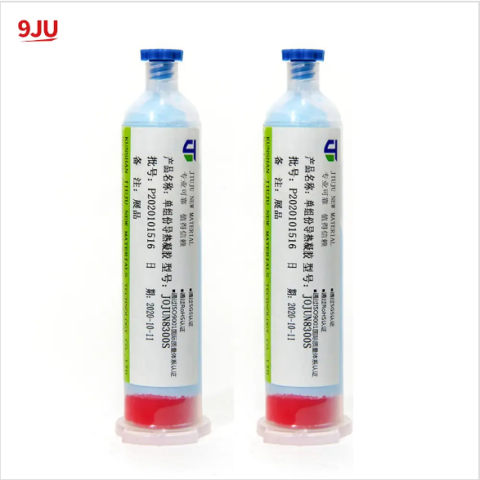Thermal paste, also known as thermal grease or thermal compound, is an important part of the electronics and computer hardware world. It is used to improve heat transfer between a heat-generating component (such as a CPU or GPU) and a heat sink or cooler. In this article, we will explore the properties and applications of thermal paste and its importance in maintaining optimal performance and longevity of electronic devices.
Characteristics of thermal paste
1. Thermal conductivity: One of the most important properties of thermal paste is its thermal conductivity. This refers to the material’s ability to conduct heat. High thermal conductivity ensures efficient transfer of heat from heating components to the heat sink, preventing overheating and potential damage to electronic devices.
2. Viscosity: The viscosity of thermal paste determines its consistency and ease of application. A paste with the right viscosity spreads easily and evenly over the surface of a CPU or GPU, ensuring maximum contact and heat transfer. It should also maintain its consistency over time to provide long-term thermal stability.
3. Non-capacitive and non-conductive: Thermal paste should be non-capacitive and non-conductive to prevent any electrical interference or short circuits. This is critical for electronic devices, where any conductivity can cause malfunction or damage.
4. Stability: Thermal paste should remain stable under different temperatures and environmental conditions. It should not dry out, harden or degrade over time as this would compromise its cooling effectiveness.
Application of thermal paste
1. Computer hardware: Thermal paste is widely used in the assembly and maintenance of computer hardware, especially CPUs, GPUs and other heating components. It is applied between the processor and heat sink to fill microscopic defects and air gaps, ensuring maximum contact and heat transfer.
2. Overclocking: Enthusiasts and professionals often overclock CPUs and GPUs to achieve higher performance. Thermal paste plays a vital role in this process, promoting efficient heat dissipation, allowing components to operate at higher frequencies without overheating.
3. Electronic equipment: Thermal paste is also used in various electronic equipment, such as laptops, game consoles, and LED lighting systems. It helps manage the heat generated by internal components, preventing thermal throttling and ensuring the longevity of your device.
4. Industrial applications: Thermal paste is suitable for industrial environments where heat dissipation is critical. It is used in power electronics, LED manufacturing and other industrial equipment to maintain optimal operating temperatures and prevent thermal failures.
The importance of thermal paste
Proper application of thermal paste is critical to the efficient operation and longevity of electronic devices. Here are some reasons why thermal paste is so important:
1. Heat dissipation: Electronic components generate heat during operation, and effective heat dissipation is crucial to prevent overheating and potential damage. Thermal paste helps transfer heat from the component to the heat sink, ensuring optimal operating temperature.
2. Performance: In high-performance computing and gaming, keeping things cool is critical to achieving optimal performance. Proper use of thermal paste helps control temperatures, allowing components to operate to their full potential without the need for thermal throttling.
3. Lifespan: Overheating will significantly shorten the life of electronic components. By effectively managing heat using thermal paste, you can extend the life of your components, thereby reducing the risk of premature failure and the need for frequent replacement.
4. Reliability: Electronic equipment used in critical applications such as servers and industrial equipment require reliable thermal management to ensure uninterrupted operation. Thermal paste plays a vital role in maintaining the reliability of these systems by preventing thermal issues.
Tips for using thermal paste
Proper application of thermal paste is critical to ensuring optimal heat transfer and performance. Here are some tips for applying thermal paste:
1. Clean surfaces: Before applying thermal paste, make sure the surfaces of the heating components and heat sink are clean and free of any old thermal paste residue or debris. Clean the surface thoroughly using isopropyl alcohol and a lint-free cloth.
2. Application method: There are many ways to apply thermal paste, such as pea-sized dot application, line application, smearing method, etc. The goal is to achieve a thin, even layer of thermal paste that covers the entire surface of the heating component without excess.
3. Quantity: It is crucial to use the right amount of thermal paste. Applying too little will result in poor heat transfer, while applying too much will cause excess paste to bleed out and create a mess. Follow the manufacturer’s guidelines for recommended amounts of thermal paste.
4. Reapply: Over time, thermal paste may dry out or lose its effectiveness. It is recommended to reapply thermal paste when reinstalling the heat sink or after a period of time to ensure optimal heat transfer.
In summary, thermal paste is a critical component in thermal management of electronic devices and computer hardware. Its properties such as thermal conductivity, viscosity and stability make it critical for efficient heat dissipation. Proper use of thermal paste is important to maintain optimal temperature, performance, and longevity of electronic components. Whether in consumer electronics or industrial applications, the role of thermal paste in heat management cannot be underestimated. By understanding its properties and applications, users can ensure effective use of thermal paste in their electronic devices and hardware.

Media Contact
Company Name: JOJUN New Material Technology Co., Ltd.
Email: Send Email
Country: China
Website: https://www.jojun.net/

